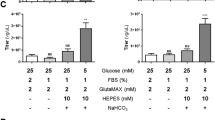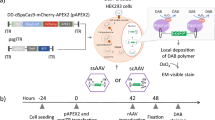Abstract
Adeno-associated virus (AAV) is a promising gene vector based on a single-stranded (ss) DNA virus. Its transgene expression requires the conversion of ssDNA to double-stranded (ds) genome, a slow process responsible for the delayed transduction and occasional inefficiency. By mutating the inverted terminal repeat, we have made novel AAV vectors that predominantly package the self-complementary dsDNA genome. The dsAAV consistently demonstrated superior and accelerated transduction in vitro and in vivo. Dramatic increases in transgene expression were observed in most of the cell lines examined, including B16 melanoma and 3LL lung cancer that are difficult to be transduced by the conventional ssAAV vectors. Similar increases were also observed in vivo in a variety of tissues including muscle and liver. The dsAAV transduced a vast majority of the hepatocytes for more than 6 months, while the ssAAV transduced only a small fraction. In addition to circumventing the requirement for DNA synthesis, the dsAAV exhibited higher in vivo DNA stability and more effective circularization than the ssAAV, suggesting potential molecular mechanisms for the faster, stronger and prolonged transgene expression.
This is a preview of subscription content, access via your institution
Access options
Subscribe to this journal
Receive 12 print issues and online access
$259.00 per year
only $21.58 per issue
Buy this article
- Purchase on Springer Link
- Instant access to full article PDF
Prices may be subject to local taxes which are calculated during checkout




Similar content being viewed by others
References
Samulski RJ, Sally M, Muzyczka N . Adeno-associated viral vectors. In: Friedmann T (ed). Development of Human Gene Therapy. Cold Spring Harbor Laboratory Press: Cold Spring Harbor, 1999, pp 131–172.
Ferrari FK, Samulski T, Shenk T, Samulski RJ . Second-strand synthesis is a rate-limiting step for efficient transduction by recombinant adeno-associated virus vectors. J Virol 1996; 70: 3227–3234.
Fisher KJ et al. Transduction with recombinant adeno-associated virus for gene therapy is limited by leading-strand synthesis. J Virol 1996; 70: 520–532.
Nakai H, Storm TA, Kay MA . Recruitment of single-stranded recombinant adeno-associated virus vector genomes and intermolecular recombination are responsible for stable transduction of liver in vivo. J Virol 2000; 74: 9451–9463.
Lewin AS et al. Ribozyme rescue of photoreceptor cells in a transgenic rat model of autosomal dominant retinitis pigmentosa [published erratum appears in Nat Med 1998 Sep;4(9):1081]. Nat Med 1998; 4: 967–971.
Ma HI et al. Suppression of intracranial human glioma growth after intramuscular administration of an adeno-associated viral vector expressing angiostatin. Cancer Res 2002; 62: 756–763.
Shimazaki K et al. Adeno-associated virus vector-mediated bcl-2 gene transfer into post-ischemic gerbil brain in vivo: prospects for gene therapy of ischemia-induced neuronal death. Gene Therapy 2000; 7: 1244–1249.
Miao CH et al. Nonrandom transduction of recombinant adeno-associated virus vectors in mouse hepatocytes in vivo: cell cycling does not influence hepatocyte transduction. J Virol 2000; 74: 3793–3803.
Song S et al. Stable therapeutic serum levels of human alpha-1 antitrypsin (AAT) after portal vein injection of recombinant adeno-associated virus (rAAV) vectors. Gene Therapy 2001; 8: 1299–1306.
Mount JD et al. Sustained phenotypic correction of hemophilia B dogs with a factor IX null mutation by liver-directed gene therapy. Blood 2002; 99: 2670–2676.
Chao H, Mao L, Bruce AT, Walsh CE . Sustained expression of human factor VIII in mice using a parvovirus-based vector. Blood 2000; 95: 1594–1599.
Xu L et al. CMV-beta-actin promoter directs higher expression from an adeno-associated viral vector in the liver than the cytomegalovirus or elongation factor 1 alpha promoter and results in therapeutic levels of human factor X in mice. Hum Gene Ther 2001; 12: 563–573.
Qing K et al. Role of tyrosine phosphorylation of a cellular protein in adeno-associated virus 2-mediated transgene expression. Proc Natl Acad Sci USA 1997; 94: 10879–10884.
Duan D et al. Endosomal processing limits gene transfer to polarized airway epithelia by adeno-associated virus. J Clin Invest 2000; 105: 1573–1587.
McCarty DM, Monahan PE, Samulski RJ . Self-complementary recombinant adeno-associated virus (scAAV) vectors promote efficient transduction independently of DNA synthesis. Gene Therapy 2001; 8: 1248–1254.
Hirata RK, Russell DW . Design and packaging of adeno-associated virus gene targeting vectors. J Virol 2000; 74: 4612–4620.
King JA, Dubielzig R, Grimm D, Kleinschmidt JA . DNA helicase-mediated packaging of adeno-associated virus type 2 genomes into preformed capsids. EMBO J 2001; 20: 3282–3291.
Clark KR, Liu X, McGrath JP, Johnson PR . Highly purified recombinant adeno-associated virus vectors are biologically active and free of detectable helper and wild-type viruses. Hum Gene Ther 1999; 10: 1031–1039.
Girod A et al. Genetic capsid modifications allow efficient re-targeting of adeno-associated virus type 2. Nat Med 1999; 5: 1052–1056.
Hansen J, Qing K, Srivastava A . Adeno-associated virus type 2-mediated gene transfer: altered endocytic processing enhances transduction efficiency in murine fibroblasts. J Virol 2001; 75: 4080–4090.
Nakai H et al. A limited number of transducible hepatocytes restricts a wide-range linear vector dose response in recombinant adeno-associated virus-mediated liver transduction. J Virol 2002; 76: 11343–11349.
Hansen J et al. Impaired intracellular trafficking of adeno-associated virus type 2 vectors limits efficient transduction of murine fibroblasts. J Virol 2000; 74: 992–996.
Duan D et al. Circular intermediates of recombinant adeno-associated virus have defined structural characteristics responsible for long-term episomal persistence in muscle tissue [published erratum appears in J Virol 1999 Jan;73(1):861]. J Virol 1998; 72: 8568–8577.
Wang JC, Lynch AS . Transcription and DNA supercoiling. Curr Opin Genet Dev 1993; 3: 764–768.
Flotte TR et al. Gene expression from adeno-associated virus vectors in airway epithelial cells. Am J Respir Cell Mol Biol 1992; 7: 349–356.
Song S, Laipis PJ, Berns KI, Flotte TR . Effect of DNA-dependent protein kinase on the molecular fate of the rAAV2 genome in skeletal muscle. Proc Natl Acad Sci USA 2001; 98: 4084–4088.
Nakai H et al. Extrachromosomal recombinant adeno-associated virus vector genomes are primarily responsible for stable liver transduction in vivo. J Virol 2001; 75: 6969–6976.
Xiao X et al. Adeno-associated virus (AAV) vector antisense gene transfer in vivo decreases GABA(A) alpha1 containing receptors and increases inferior collicular seizure sensitivity. Brain Res 1997; 756: 76–83.
McCaffrey AP et al. RNA interference in adult mice. Nature 2002; 418: 38–39.
Xiao X, Li J, Samulski RJ . Production of high-titer recombinant adeno-associated virus vectors in the absence of helper adenovirus. J Virol 1998; 72: 2224–2232.
Snyder R, Xiao X, Samulski RJ . Production of recombinant adeno-asociated viral vectors. In: Smith D (ed). Current Protocols in Human Genetics. John Wiley & Sons Ltd: New York, 1996: 12.1.1–12.2.23.
Acknowledgements
We thank Paul. Monahan and Michael Xiao for critical reading of the manuscript. This work is supported by NIH Grants AR45967 and AR45925.
Author information
Authors and Affiliations
Rights and permissions
About this article
Cite this article
Wang, Z., Ma, HI., Li, J. et al. Rapid and highly efficient transduction by double-stranded adeno-associated virus vectors in vitro and in vivo. Gene Ther 10, 2105–2111 (2003). https://doi.org/10.1038/sj.gt.3302133
Received:
Accepted:
Published:
Issue Date:
DOI: https://doi.org/10.1038/sj.gt.3302133
Keywords
This article is cited by
-
One episode of low intensity aerobic exercise prior to systemic AAV9 administration augments transgene delivery to the heart and skeletal muscle
Journal of Translational Medicine (2023)
-
Targeting mAKAPβ expression as a therapeutic approach for ischemic cardiomyopathy
Gene Therapy (2023)
-
Systemic AAV6-synapsin-GFP administration results in lower liver biodistribution, compared to AAV1&2 and AAV9, with neuronal expression following ultrasound-mediated brain delivery
Scientific Reports (2021)
-
Biodistribution of onasemnogene abeparvovec DNA, mRNA and SMN protein in human tissue
Nature Medicine (2021)
-
Bone-targeting AAV-mediated silencing of Schnurri-3 prevents bone loss in osteoporosis
Nature Communications (2019)



